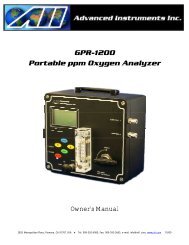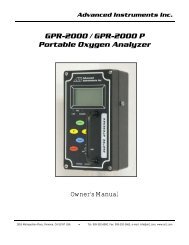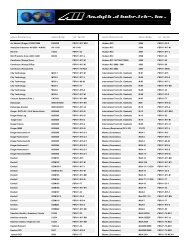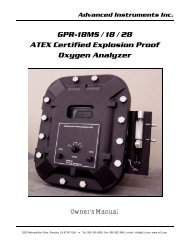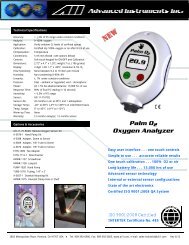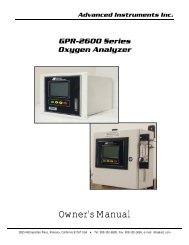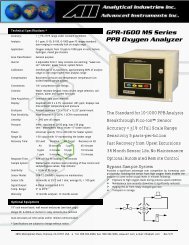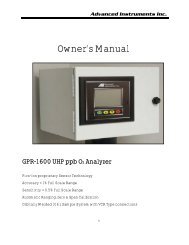GPR-1800 AIS ATEX Trace PPM Oxygen Analyzer - Advanced ...
GPR-1800 AIS ATEX Trace PPM Oxygen Analyzer - Advanced ...
GPR-1800 AIS ATEX Trace PPM Oxygen Analyzer - Advanced ...
- No tags were found...
You also want an ePaper? Increase the reach of your titles
YUMPU automatically turns print PDFs into web optimized ePapers that Google loves.
<strong>Advanced</strong> Instruments Inc.Installation ConsiderationsGas Sample Stream: Ensure the gas stream composition of the application is consistent with the specifications and review theapplication conditions before initiating the installation. Consult the factory if necessary to ensure the sample is suitable foranalysis.Note: In natural gas applications such as extraction and transmission, a low voltage current is applied to the pipeline itself toinhibit corrosion. As a result, electronic devices can be affected unless adequately grounded.Contaminant Gases: A gas scrubber and flow indicator with integral metering valve are required upstream of the transmitterto remove interfering gases such as oxides of sulfur and nitrogen or hydrogen sulfide that can produce false readings, reducethe expected life of the sensor and void the sensor warranty if not identified at time of order placement. Installation of asuitable scrubber is required to remove the contaminant from the sample gas to prevent erroneous analysis readings anddamage to the sensor or optional components. Consult the factory for recommendations concerning the proper selection andinstallation of components.Expected Sensor Life: With reference to the publish specification located as the last page of this manual, the expected life ofall oxygen sensors is predicated on oxygen concentration (< 1000 ppm or air), temperature (77°F/25°C) and pressure (1atmosphere) in “normal” applications. Deviations are outside the specifications and will affect the life of the sensor. As a rule ofthumb sensor life is inversely proportional to changes in the parameters.Optimum Accuracy: Determine if Zero Calibration is recommended for your application. If it is Zero Calibration shouldprecede Span Calibration and both should be repeated after the analyzer has been allowed to stabilize, typically 24-36 hoursafter installation. For Span Calibration use a certified span gas with an oxygen content (balance nitrogen) approximating 80% ofthe next higher full scale range above the intended measuring range is recommended for optimum accuracy, see Calibrationand Accuracy.Assuming the initial zero is performed according to the procedure described herein, the analyzer should not require ZeroCalibration again until the either the sensor is replaced or a change is made to the sample system or gas lines, and, it shouldnot require Span Calibration again for up to 3 months under “normal” application conditions as described in the publishedspecifications. One of the unique features of analyzers based on the electrochemical galvanic fuel cell type oxygen sensor is thefact that it can be field calibrated at the user’s discretion to whatever standard of certified span gas the user elects to use.Zero Calibration: In theory, the oxygen sensor produces no signal output when exposed to an oxygen free sample gas. Inreality, expect the transmitter to generate an oxygen reading when sampling oxygen free sample gas due to contamination orquality of the zero gas; minor leakage in the sample line connections; residual oxygen dissolved in the sensor’s electrolyte; and,tolerances of the electronic components.Zero calibration, see Determining True Zero Offset below, is recommended only for online analyzers performing continuousanalysis below 5% of the lowest most sensitive range available with a ppm analyzer, e.g. analysis below 0.5 ppm on the 10 ppmrange, or below 0.1% (1000 ppm) with a percent analyzer. Note : Once the zero offset adjustment is made, zero calibration isnot required again until the sample system connections are modified, or, when installing a new oxygen sensor. As a result, zerocalibration is not practical and therefore not recommended for higher ranges or portable analyzers.Determining True Zero Offset: Allow the transmitter approximately 24 hours to stabilize with flowing zero gas as evidenced by astable reading or horizontal trend on an external recording device. Note: 24 hours is required to assure the sensor hasconsumed the oxygen that has dissolved into the electrolyte inside the sensor while exposed to air or percentage levels ofoxygen. For optimum accuracy, utilize as much of the actual sample system as possible.Span Calibration: Involves adjusting the transmitter electronics to the sensor’s signal output at a given oxygen standard, e.g.a certified span gas with an oxygen content (balance nitrogen) approximating 80% of the next higher full scale range above theintended measuring range is recommended for optimum accuracy, see Calibration and Accuracy.9



